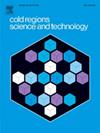A novel electroosmosis-heating method for heaving reduction of sulfate saline soil during cooling process
IF 3.8
2区 工程技术
Q1 ENGINEERING, CIVIL
引用次数: 0
Abstract
The salt heaving of sulfate saline soil seriously affects the safety and service lives of various facilities in saline soil areas worldwide. Electrosmosis-heating (EOH) can theoretically mitigate the serious influence, but its mechanism is unclear. A series of salt heaving and microscopic experiments were conducted using EOH and electron microscopy, respectively. Soil temperature, relative humidity (RH), salt heaving and microstructure in the experiment were monitored and analyzed at different electric potential gradients and electrode sizes. The experimental results show that salt heaving can be effectively reduced by EOH. Soil temperature, RH, salt heaving and its reduction increase with increasing electric potential gradient and electrode size. The above variables increase with time at relatively high electric potential gradients while the first two variables are reduced under lower ones. The mechanism of EOH heaving reduction is the increase of soil temperature and RH caused by heating, the reduction of water and salt content induced by electroosmosis, and pore space is reduced. The effects of electroosmosis and heating on the reduction of salt heaving decrease and increase respectively with the rise of potential gradient. This research provides a theoretical basis for using the EOH method to prevent salt heaving in sulfate saline soils.
一种用于硫酸盐盐渍土冷却过程中起皱的新型电渗透加热方法
硫酸盐盐渍土的盐胀严重影响着世界范围内盐渍地区各种设施的安全和使用寿命。电渗加热(EOH)理论上可以减轻严重的影响,但其机制尚不清楚。采用EOH和电镜分别进行了一系列的盐胀和微观实验。对不同电位梯度和电极尺寸下的土壤温度、相对湿度、盐胀和微观结构进行了监测和分析。实验结果表明,EOH能有效地抑制盐胀。随着电势梯度和电极尺寸的增大,土壤温度、相对湿度、盐胀及其减量均增大。较高电位梯度下,上述变量随时间增加,较低电位梯度下,前两个变量随时间减少。EOH起伏减少的机理是加热引起的土壤温度和相对湿度升高,电渗透引起的水盐含量降低,孔隙空间缩小。随着电位梯度的增大,电渗和加热对盐胀的抑制作用分别减弱和增强。本研究为利用EOH法防治硫酸盐盐渍土中的盐胀提供了理论依据。
本文章由计算机程序翻译,如有差异,请以英文原文为准。
求助全文
约1分钟内获得全文
求助全文
来源期刊

Cold Regions Science and Technology
工程技术-地球科学综合
CiteScore
7.40
自引率
12.20%
发文量
209
审稿时长
4.9 months
期刊介绍:
Cold Regions Science and Technology is an international journal dealing with the science and technical problems of cold environments in both the polar regions and more temperate locations. It includes fundamental aspects of cryospheric sciences which have applications for cold regions problems as well as engineering topics which relate to the cryosphere.
Emphasis is given to applied science with broad coverage of the physical and mechanical aspects of ice (including glaciers and sea ice), snow and snow avalanches, ice-water systems, ice-bonded soils and permafrost.
Relevant aspects of Earth science, materials science, offshore and river ice engineering are also of primary interest. These include icing of ships and structures as well as trafficability in cold environments. Technological advances for cold regions in research, development, and engineering practice are relevant to the journal. Theoretical papers must include a detailed discussion of the potential application of the theory to address cold regions problems. The journal serves a wide range of specialists, providing a medium for interdisciplinary communication and a convenient source of reference.
 求助内容:
求助内容: 应助结果提醒方式:
应助结果提醒方式:


